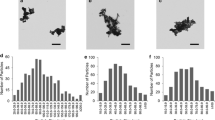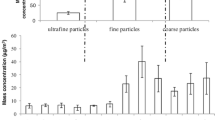Abstract
The increasing trend of nanoparticle usage in science and technology has led to significant human exposure. Occupational exposure to iron oxides and silica dust has been reported in mining, manufacturing, construction, and pharmaceutical operations. The combined toxicological effects of nanoparticles and simultaneous exposure to other compounds have given rise to a new concern. Hence, the objective of this study was to investigate the toxicological effects of magnetite and polymorphous silicon dioxide nanoparticles in single and combined exposures. The polymorphous silicon dioxide nanoparticles were obtained from the milled quartz particles under 100 nm in diameter. The milled particles were purified through chloric and nitric acid wash processes. The toxic effects of the magnetite nanoparticles were investigated independently and in combination with quartz using the A549 cell line for durations of 24 and 72 h, and using diverse concentrations of 10, 50, 100, and 250 μg/mL. MTT, ROS, mitochondrial membrane potential, and cell glutathione content assays were used to evaluate the amount of cell damage in this study. The statistical significance level in one-way ANOVA and independent t test was considered to be at the 5% confidence level. The size and purity of polymorphous silicon dioxide nanoparticles were measured by TEM and ICP-OES analysis, respectively. The particles’ diameters were under 100 nm and demonstrated a purity of higher than 99%. The toxicity results of this study showed a dependency on concentration and exposure duration in reducing the cell viability, cellular glutathione content, and mitochondrial membrane potential, as well as increasing the ROS generation in single and combined exposures with magnetite and polymorphous silicon dioxide nanoparticles. The toxic effects of combined exposure to these nanoparticles were less than the single exposures, and statistically significant antagonistic interactions were detected. Combined exposure to polymorphous silicon dioxide and magnetite nanoparticles, in comparison with their single exposures, could affect health in an antagonistic manner. Since this study has been the first of its kind, further studies investigating the health effects of single and combined exposures to these compounds are needed to verify our findings. Generally, studies such as this one could contribute to the field of combined toxicity effects.











Similar content being viewed by others
References
Al Mallakh R & El Mallakh R (2015) Saudi Arabia: rush to development (RLE Economy of Middle East): profile of an energy economy and investment, Routledge.
Andersson B, Aw T, Jones D (1987) Mitochondrial transmembrane potential and pH gradient during anoxia. Am J Phys Cell Phys 252:C349–C355
Basu S, Stuckler D, Gonsalves G, Lurie M (2009) The production of consumption: addressing the impact of mineral mining on tuberculosis in southern Africa. Glob Health 5:11
Borm PJ (2002) Particle toxicology: from coal mining to nanotechnology. Inhal Toxicol 14:311–324
Bourgkard E, Wild P, Courcot B, Diss M, Ettlinger J, Goutet P, Hémon D, Marquis N, Mur J-M, Rigal C (2008) Lung cancer mortality and iron oxide exposure in a French steel-producing factory. Occup Environ Med 66:175–181
Cedervall T, Lynch I, Lindman S, Berggård T, Thulin E, Nilsson H, Dawson KA, Linse S (2007) Understanding the nanoparticle–protein corona using methods to quantify exchange rates and affinities of proteins for nanoparticles. Proc Natl Acad Sci 104:2050–2055
Corbo C, Molinaro R, Parodi A, Toledano Furman NE, Salvatore F, Tasciotti E (2016) The impact of nanoparticle protein corona on cytotoxicity, immunotoxicity and target drug delivery. Nanomedicine 11:81–100
Deng ZJ, Mortimer G, Schiller T, Musumeci A, Martin D, Minchin RF (2009) Differential plasma protein binding to metal oxide nanoparticles. Nanotechnology 20:455101
Ding Y, Kuhlbusch TA, Van Tongeren M, Jiménez AS, Tuinman I, Chen R, Alvarez IL, Mikolajczyk U, Nickel C, Meyer J (2017) Airborne engineered nanomaterials in the workplace—a review of release and worker exposure during nanomaterial production and handling processes. J Hazard Mater 322:17–28
Driscoll T, Nelson DI, Steenland K, Leigh J, Concha-Barrientos M, Fingerhut M, Prüss-Üstün A (2005) The global burden of disease due to occupational carcinogens. Am J Ind Med 48:419–431
Ellman GL (1959) Tissue sulfhydryl groups. Arch Biochem Biophys 82:70–77
Fubini B, Hubbard A (2003) Reactive oxygen species (ROS) and reactive nitrogen species (RNS) generation by silica in inflammation and fibrosis. Free Radic Biol Med 34:1507–1516
Geiger A, Cooper J (2010) Overview of airborne metals regulations, exposure limits, health effects, and contemporary research. Environmental Protection Agency, Air Quality, Washington
Ghio AJ, Kummarapurugu ST, Tong H, Soukup JM, Dailey LA, Boykin E, Ian Gilmour M, Ingram P, Roggli VL, Goldstein HL (2014) Biological effects of desert dust in respiratory epithelial cells and a murine model. Inhal Toxicol 26:299–309
Guo B, Zebda R, Drake SJ, Sayes CM (2009) Synergistic effect of co-exposure to carbon black and Fe 2 O 3 nanoparticles on oxidative stress in cultured lung epithelial cells. Part Fibre Toxicol 6:4
Guo M, Xu X, Yan X, Wang S, Gao S, Zhu S (2013) In vivo biodistribution and synergistic toxicity of silica nanoparticles and cadmium chloride in mice. J Hazard Mater 260:780–788
Harrison J, Chen JQ, Miller W, Chen W, Hnizdo E, Lu J, Chisholm W, Keane M, Gao P, Wallace W (2005) Risk of silicosis in cohorts of Chinese tin and tungsten miners and pottery workers (II): workplace-specific silica particle surface composition. Am J Ind Med 48:10–15
Hestnes K, Aasly K, Sandøy R, Sørensen B (2013) Occurrence of iron in industrial granitic pegmatite. Miner Eng 52:21–30
Kuang L, Mitchell BS, Fink MJ (2015) Silicon nanoparticles synthesised through reactive high-energy ball milling: enhancement of optical properties from the removal of iron impurities. J Exp Nanosci 10:1214–1222
Lebel CP, Ischiropoulos H, Bondy SC (1992) Evaluation of the probe 2′, 7′-dichlorofluorescin as an indicator of reactive oxygen species formation and oxidative stress. Chem Res Toxicol 5:227–231
Lesniak A, Fenaroli F, Monopoli MP, Åberg C, Dawson KA, Salvati A (2012) Effects of the presence or absence of a protein corona on silica nanoparticle uptake and impact on cells. ACS Nano 6:5845–5857
Leung C, Yu I & Chen W (2012) Silicosis Lancet. 379 (9830): 2008–18.
Lim SS, Vos T, Flaxman AD, Danaei G, Shibuya K, Adair-Rohani H, Almazroa MA, Amann M, Anderson HR, Andrews KG (2012) A comparative risk assessment of burden of disease and injury attributable to 67 risk factors and risk factor clusters in 21 regions, 1990–2010: a systematic analysis for the Global Burden of Disease Study 2010. Lancet 380:2224–2260
Lin W, Huang Y-W, Zhou X-D, Ma Y (2006) In vitro toxicity of silica nanoparticles in human lung cancer cells. Toxicol Appl Pharmacol 217:252–259
lövestam G, Rauscher H, Roebben G, Kluttgen BS, Gibson N, Putaud JP, Stamm H (2010) Considerations on a definition of nanomaterial for regulatory purposes. Joint Research Centre (JRC) Reference Reports, 80004-1. Available: https://ec.europa.eu/jrc/sites/jrcsh/files/jrc_reference_report_201007_nanomaterials.pdf
Maher BA, Taylor RM (1988) Formation of ultrafine-grained magnetite in soils. Nature 336:368–370
Mesárošová M, Kozics K, Bábelová A, Regendová E, Pastorek M, Vnuková D, Buliaková B, Rázga F, Gábelová A (2014) The role of reactive oxygen species in the genotoxicity of surface-modified magnetite nanoparticles. Toxicol Lett 226:303–313
Mishra A (2015) Impact of silica mining on environment. J Geogr Reg Plan 8:150–156
Montasser I, Fessi H, Coleman A (2002) Atomic force microscopy imaging of novel type of polymeric colloidal nanostructures. Eur J Pharm Biopharm 54:281–284
Mosmann T (1983) Rapid colorimetric assay for cellular growth and survival: application to proliferation and cytotoxicity assays. J Immunol Methods 65:55–63
Moulin J, Clavel T, Roy D, Dananche B, Marquis N, Févotte J, Fontana J (2000) Risk of lung cancer in workers producing stainless steel and metallic alloys. Int Arch Occup Environ Health 73:171–180
Núñez MT, Gallardo V, Muñoz P, Tapia V, Esparza A, Salazar J, Speisky H (2004) Progressive iron accumulation induces a biphasic change in the glutathione content of neuroblastoma cells. Free Radic Biol Med 37:953–960
Oberdörster G (2000) Pulmonary effects of inhaled ultrafine particles. Int Arch Occup Environ Health 74:1–8
Okoturo-Evans O, Dybowska A, Valsami-Jones E, Cupitt J, Gierula M, Boobis AR, Edwards RJ (2013) Elucidation of toxicity pathways in lung epithelial cells induced by silicon dioxide nanoparticles. PLoS One 8:e72363
Pavan C, Turci F, Tomatis M, Ghiazza M, Lison D, Fubini B (2017) Ζ potential evidences silanol heterogeneity induced by metal contaminants at the quartz surface: implications in membrane damage. Colloids Surf B: Biointerfaces 157:449–455
Poinen-Rughooputh S, Rughooputh MS, Guo Y, Rong Y, Chen W (2016) Occupational exposure to silica dust and risk of lung cancer: an updated meta-analysis of epidemiological studies. BMC Public Health 16:1137
Politis M, Pilinis C, Lekkas T (2008) Ultrafine Particles (UFP) and Health Effects. Dangerous. Like No Other PM? Review and Analysis. Global NEST J 10:439–452
Rivas-Sánchez M, Alva-Valdivia L, Arenas-Alatorre J, Urrutia-Fucugauchi J, Perrin M, Goguitchaichvili A, Ruiz-Sandoval M, Molina MR (2009) Natural magnetite nanoparticles from an iron-ore deposit: size dependence on magnetic properties. Earth, planets and space 61:151–160
Shi X, Dalai N, Hu XN, Vallyathan V (1989) The chemical properties of silica particle surface in relation to silica-cell interactions. J Toxicol Environ Health Part A Curr Issues 27:435–454
Stark WJ, Stoessel PR, Wohlleben W, Hafner A (2015) Industrial applications of nanoparticles. Chem Soc Rev 44:5793–5805
Tenzer S, Docter D, Kuharev J, Musyanovych A, Fetz V, Hecht R, Schlenk F, Fischer D, Kiouptsi K, Reinhardt C (2013) Rapid formation of plasma protein corona critically affects nanoparticle pathophysiology. Nat Nanotechnol 8:772–781
Torén K, Bergdahl IA, Nilsson TK, Järvholm B (2007) Occupational exposure to particulate air pollution and mortality due to ischemic heart disease and cerebrovascular disease. Occup Environ Med 64:515–519
Turci F, Pavan C, Leinardi R, Tomatis M, Pastero L, Garry D, Anguissola S, Lison D, Fubini B (2015) Revisiting the paradigm of silica pathogenicity with synthetic quartz crystals: the role of crystallinity and surface disorder. Part Fibre Toxicol 13:32
Vallius M (2005) Characteristics and sources of fine particulate matter in urban air, National Public Health Institute.
Van Berlo D, Hullmann M & Schins RP (2012) Toxicology of ambient particulate matter. Molecular, Clinical and Environmental Toxicology. Springer.
Wang Y, Peng X, Shi J, Tang X, Jiang J, Liu W (2012) Highly selective fluorescent chemosensor for Zn 2+ derived from inorganic-organic hybrid magnetic core/shell Fe 3 O 4@ SiO 2 nanoparticles. Nanoscale Res Lett 7:86
Yassin A, Yebesi F, Tingle R (2005) Occupational exposure to crystalline silica dust in the United States, 1988–2003. Environ Health Perspect 113:255–260
Yongbo Y, Junchao D, Yang L, Yang Y, Minghua J, Li C, Yapei W, Zhiwe IS (2015) Combined toxicity of amorphous silica nanoparticles and methylmercury to human lung epithelial cells. Ecotoxicol Environ Saf 112:144–152
Yu Y, Duan J, Li Y, Yu Y, Jin M, Li C, Wang Y, Sun Z (2015) Combined toxicity of amorphous silica nanoparticles and methylmercury to human lung epithelial cells. Ecotoxicol Environ Saf 112:144–152
Zhang Z, Shen H-M, Zhang Q-F, Ong C-N (2000) Involvement of oxidative stress in crystalline silica-induced cytotoxicity and genotoxicity in rat alveolar macrophages. Environ Res 82:245–252
Zong L, Zhu B, Lu Z, Tan Y, Jin Y, Liu N, Hu Y, Gu S, Zhu J, Cui Y (2015) Nanopurification of silicon from 84% to 99.999% purity with a simple and scalable process. Proc Natl Acad Sci 112:13473–13477
Acknowledgment
The authors of this article are grateful to the Neuroscience Research Center and the Public Health and Safety School of Shahid Beheshti University of Medical Sciences for providing laboratory facilities.
Funding
The authors of this study received three research grants from the various branches of the Shahid Beheshti University of Medical Sciences such as; Nanomedicine and Tissue Engineering Research Center, The School of Public Health & Safety and the Office of Vice-Chancellor of Research Affairs with a code of IR.SBMU.PHNS.REC.1396.38.
Author information
Authors and Affiliations
Corresponding author
Additional information
Responsible editor: Philippe Garrigues
Publisher’s note
Springer Nature remains neutral with regard to jurisdictional claims in published maps and institutional affiliations.
Rights and permissions
About this article
Cite this article
Rafieepour, A., Azari, M.R., Khodagholi, F. et al. The effect of single and combined exposures to magnetite and polymorphous silicon dioxide nanoparticles on the human A549 cell line: in vitro study. Environ Sci Pollut Res 26, 31752–31762 (2019). https://doi.org/10.1007/s11356-019-06229-0
Received:
Accepted:
Published:
Issue Date:
DOI: https://doi.org/10.1007/s11356-019-06229-0




